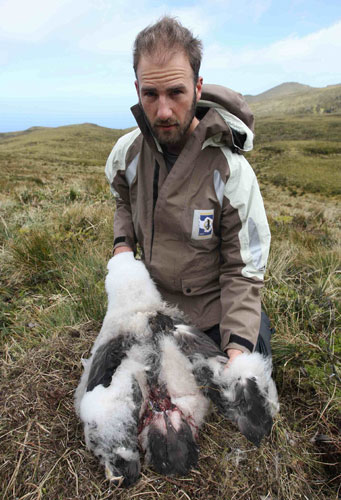The UK Environment Minister Richard Benyon announced funding of UK£250 000 towards a Royal Society for the Protection of Birds (RSPB) project to eradicate the introduced "killer" House Mice Mus musculus mice on Gough Island at a meeting of the UK Overseas Territories Consultative Council on 24 November last year. The funding will be used to plan and implement an eradication exercise on Gough Island, to be achieved by two aerial applications of brodifacoum poison bait from helicopters over the whole of the island.
Gough Island is considered to be one of the most important seabird breeding sites in the world. It is host to almost the entire world population of the Critically Endangered Tristan Albatross Diomedea dabbenena whose chicks are literally eaten alive by House Mice every year (click here). The endemic and Critically Endangered Gough Bunting Rowettia goughensis is also seriously at risk to the mice.
Environment Minister Richard Benyon said: "our support for this important project proves our determination to protect endangered species, wherever they are in the world. Many plants and animals that live in our Overseas Territories are found nowhere else in the world, and this funding is a significant step towards ensuring their survival. We need to take action before it's too late and birds such as the Tristan Albatross whose chicks are being eaten alive by house mice on Gough Island are lost forever".
Following a review of impacts and a feasibility study, a draft operational plan for eradicating the House Mouse from Gough Island has been compiled. The RSPB is currently engaged in fulfilling the research and planning requirements outlined in this plan. The Department for Environment, Food and Rural Affairs (Defra) funding will be used to advance implementation of the plan, as well as in fundraising to leverage further donations. The total cost of the eradication exercise is estimated by the RSPB to be of the order of UK£4-5 million.

A dying Tristan Albatross chick attacked by House Mice
Photograph by Peter Ryan
Selected references:
Angel, A. & Cooper, J. 2006. A review of the impacts of introduced rodents on the Islands of Tristan da Cunha and Gough (South Atlantic). RSPB Research Report No. 17. Sandy: Royal Society for the Protection of Birds. 64 pp.
Hilton, G.M. 2007. Workshop Report: Assessing Management Options for the Introduced Rodents of Tristan Da Cunha. Unpublished Report to the Royal Society for the Protection of Birds. Sandy: Royal Society for the Protection of Birds. 22 pp.
Parkes, J 2008. A feasibility study for the eradication of House Mice from Gough Island. RSPB Research Report No.34. Sandy: Royal Society for the Protection of Birds. 52 pp.
Torr, N., Golding, C. & Cuthbert, R.[J.] 2010. Preliminary Operational Plan for Eradicating House Mice from Gough Island. Version 1.0. Sandy: Royal Society for the Protection of Birds. 73 pp.
With thanks to Stacey Hughes, CITES & International Species Policy Team, Department for Environment, Food and Rural Affairs, UK for information.
John Cooper, ACAP Information Officer, 1 February 2012

 English
English  Français
Français  Español
Español